Abstract
Treatment of newly hatched chicks with silica by the intraperitoneal route delayed the onset of mortalities due to the JM strain of Marek's disease (MD' virus inoculated at 6 days of age. During the 88-day observation period fewer silica-treated chicks died of MD, but this difference was not usually statistically significant. Silica treatment had no effect on the susceptibility of 4-week-old birds. Silica treatment reduced the antibody response to MD but, in general, not significantly. The antibody response to bovine serum albumin was significantly enhanced if measured by the indirect hemagglutination test but not if measured by the agar gel diffusion test, whereas the response to Brucella abortus was enhanced significantly in N-line (MD-resistant) chicks but not significantly in P-line (MD-susceptible) chicks. Five days after infection, silica-treated chicks had significantly less fluorescing antigen in thymus and bursa than did untreated chicks; no difference was observed in the spleen. After silica treatment the glass-adherent cell population in the buffy coat was increased by up to 10-fold compared with untreated chicks. It is suggested that silica treatment induced macrophage proliferation, with subsequent restriction of MD virus spread, yet allowed an adjuvant-type effect with other antigens.
Full text
PDF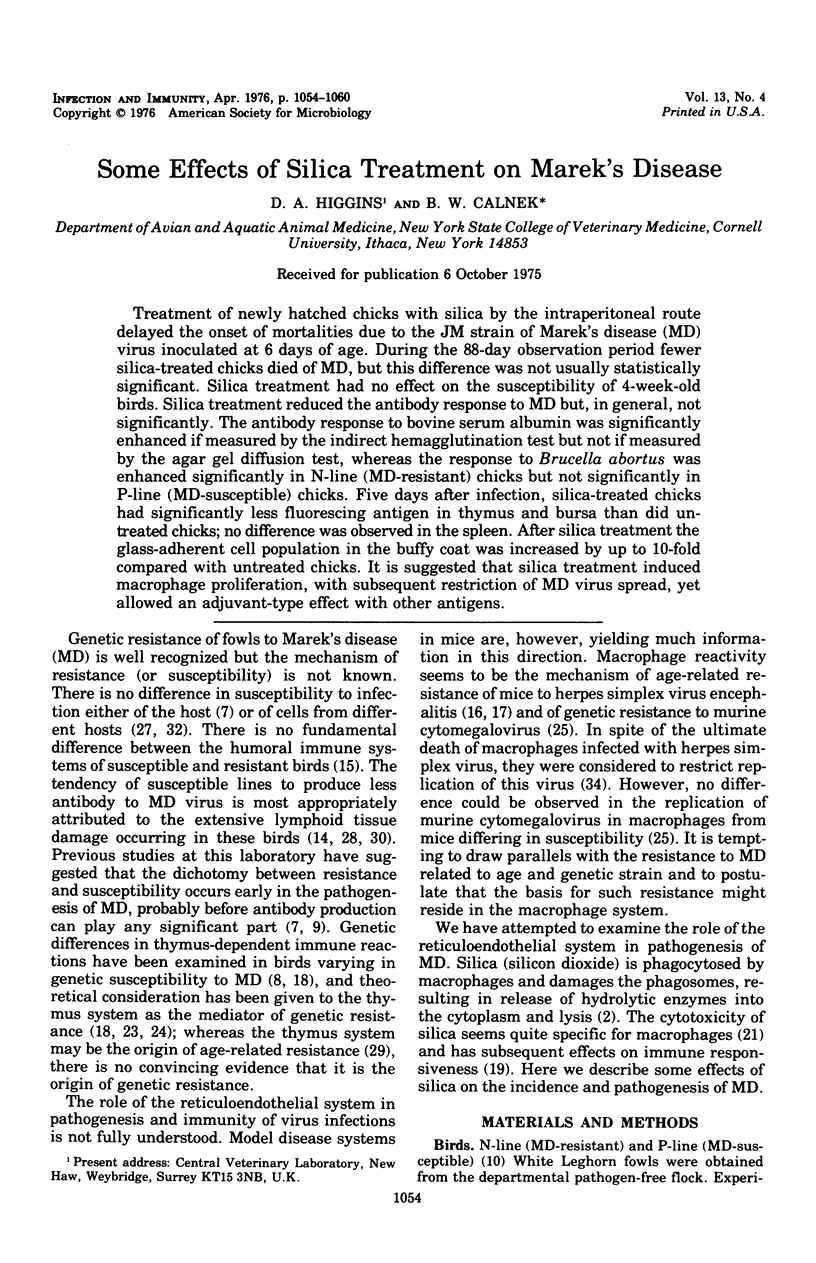
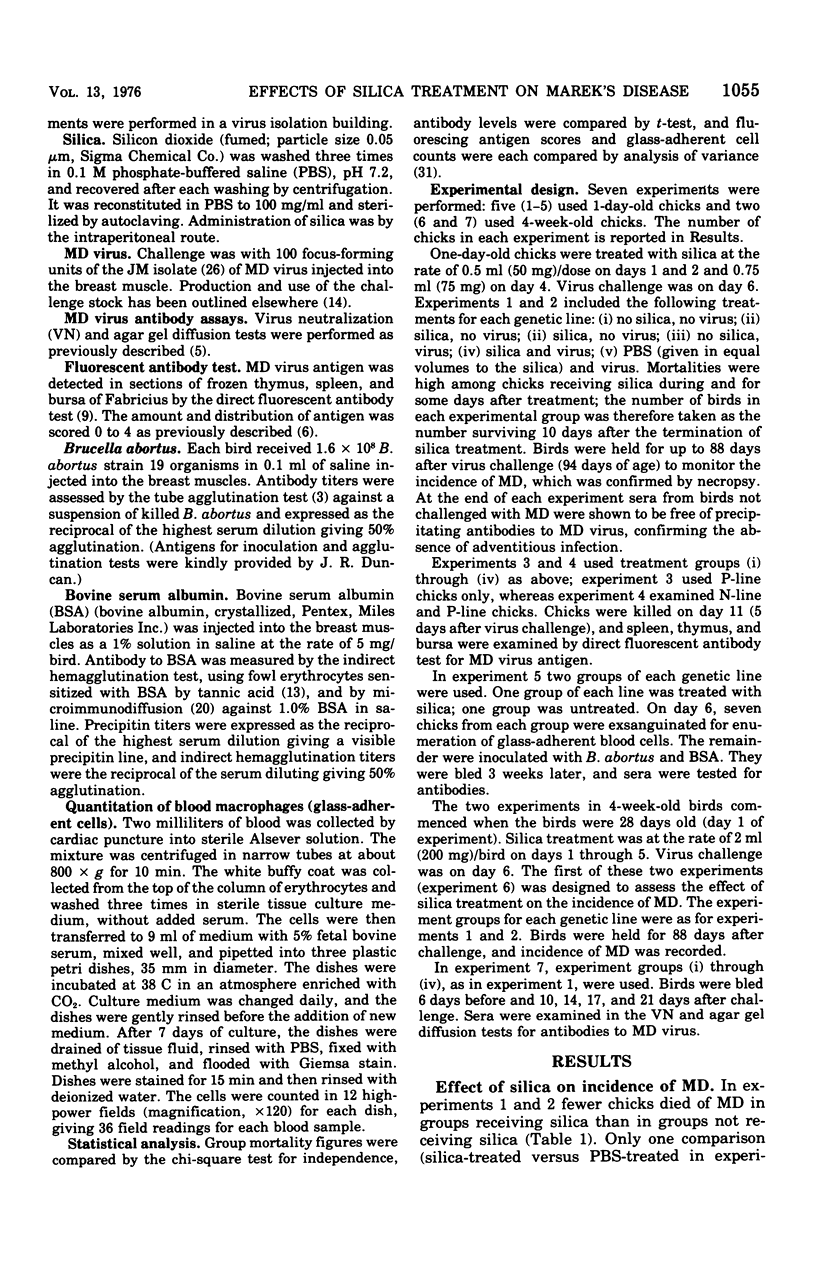
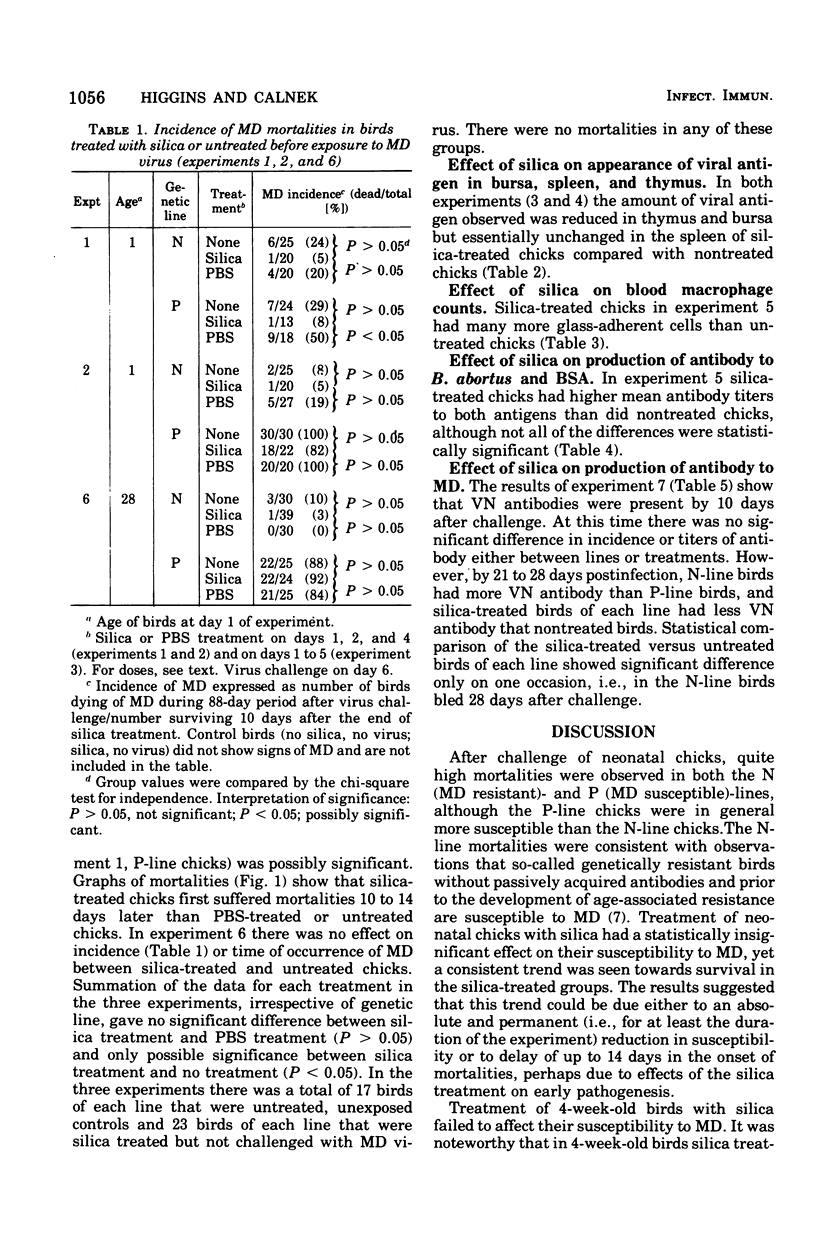
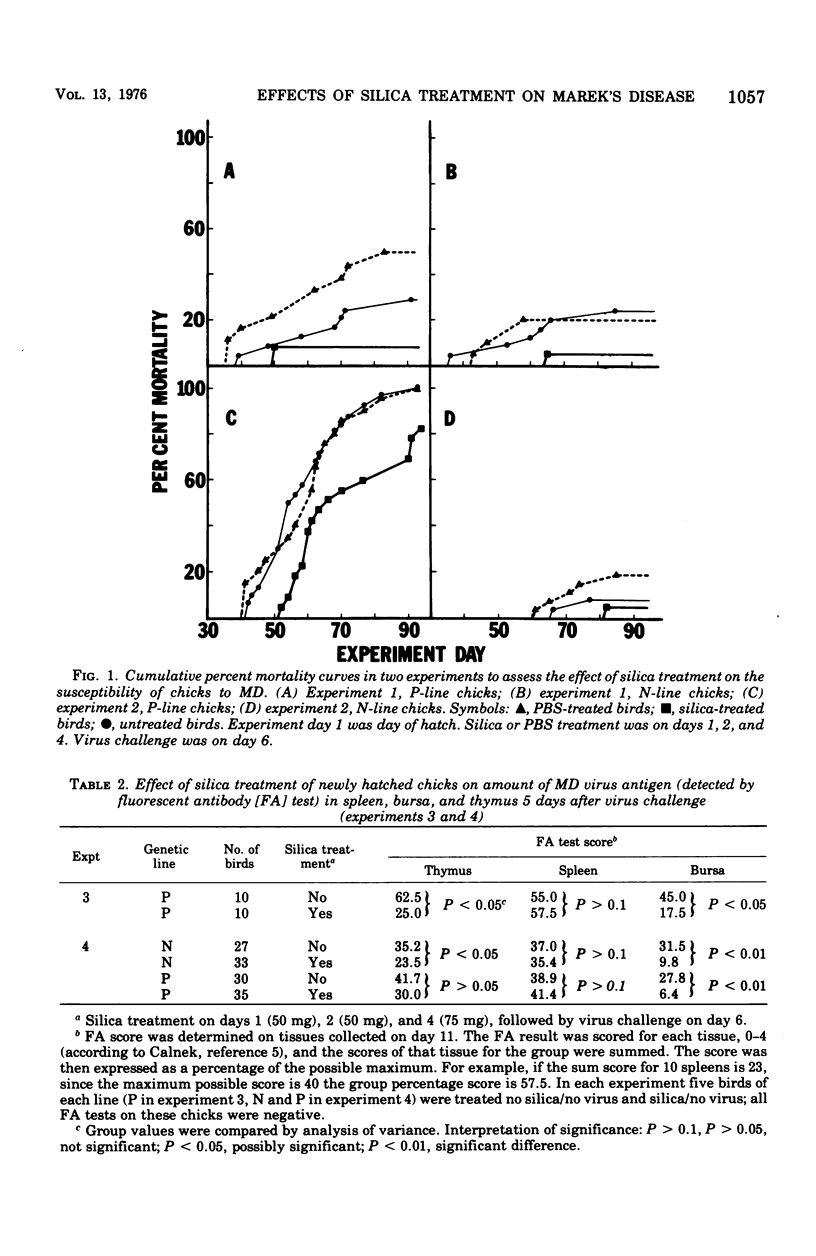
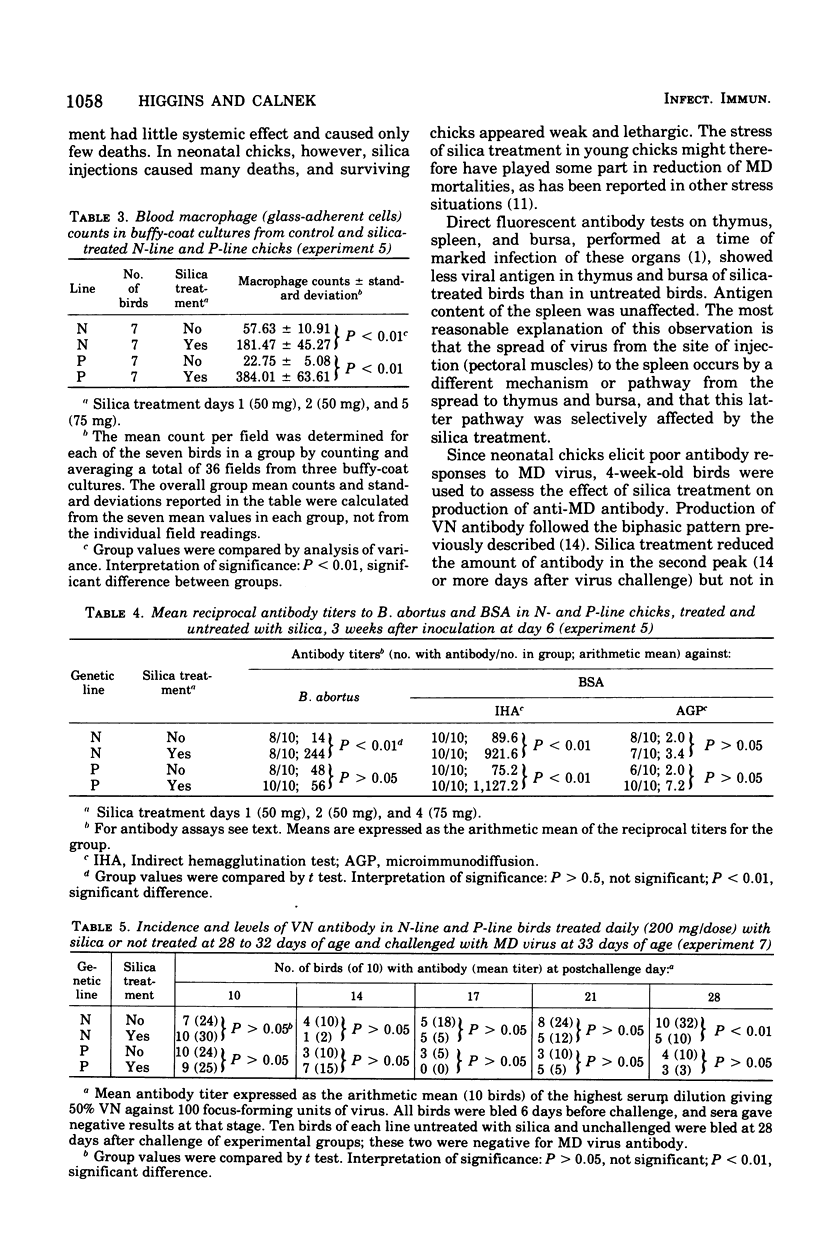
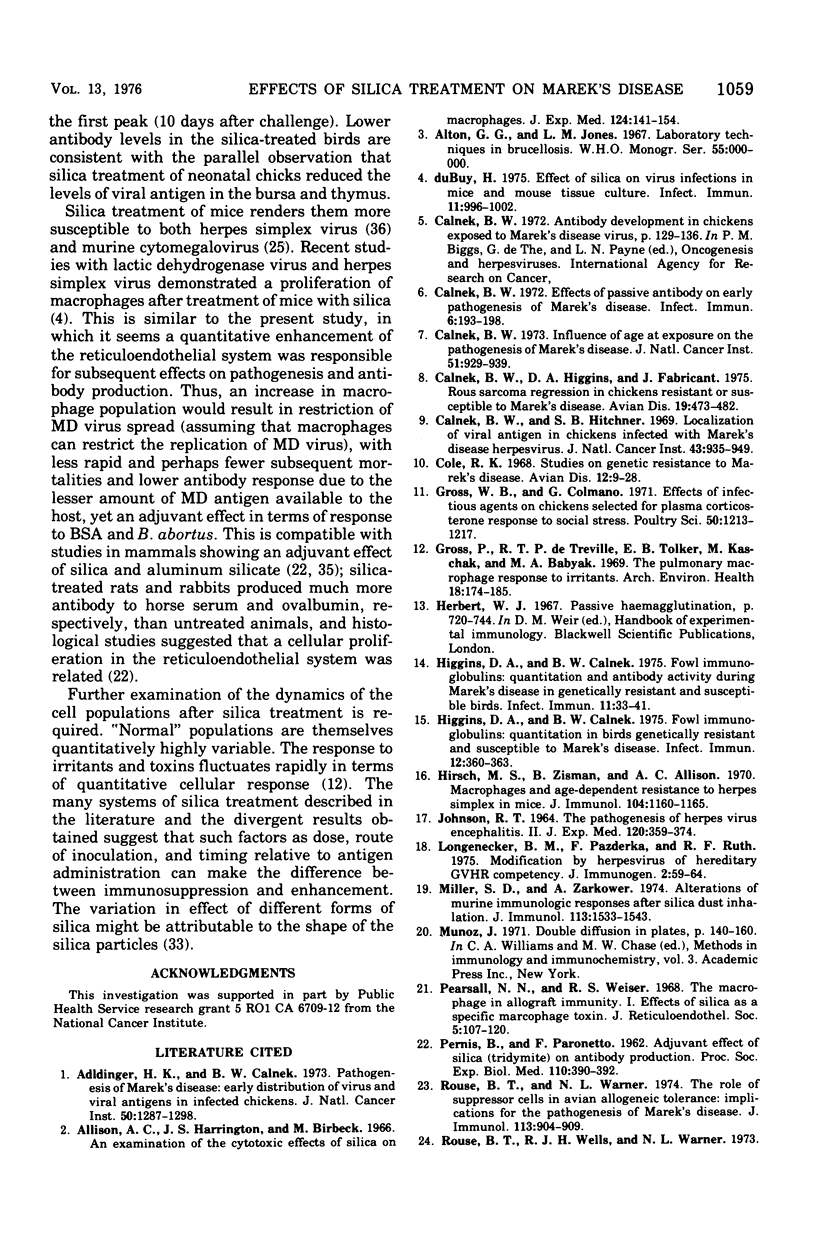
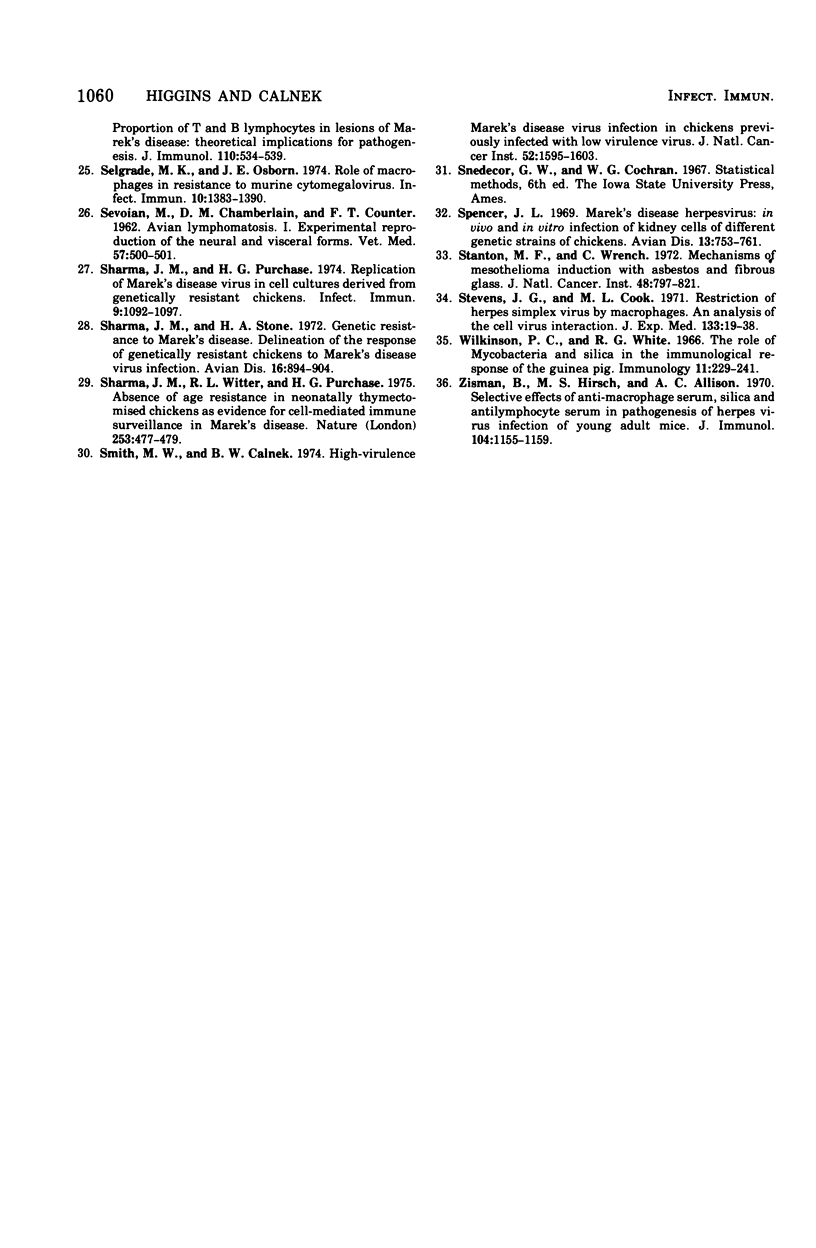
Selected References
These references are in PubMed. This may not be the complete list of references from this article.
- Addinger H. K., Calnek B. W. Pathogenesis of Marek's disease: early distribution of virus and viral antigens in infected chickens. J Natl Cancer Inst. 1973 May;50(5):1287–1298. doi: 10.1093/jnci/50.5.1287. [DOI] [PubMed] [Google Scholar]
- Allison A. C., Harington J. S., Birbeck M. An examination of the cytotoxic effects of silica on macrophages. J Exp Med. 1966 Aug 1;124(2):141–154. doi: 10.1084/jem.124.2.141. [DOI] [PMC free article] [PubMed] [Google Scholar]
- Calnek B. W. Effects of passive antibody on early pathogenesis of Marek's disease. Infect Immun. 1972 Aug;6(2):193–198. doi: 10.1128/iai.6.2.193-198.1972. [DOI] [PMC free article] [PubMed] [Google Scholar]
- Calnek B. W., Higgins D. A., Fabricant J. Rous sarcoma regression in chickens resistant or susceptible to Marek's disease. Avian Dis. 1975 Jul-Sep;19(3):473–482. [PubMed] [Google Scholar]
- Calnek B. W., Hitchner S. B. Localization of viral antigen in chickens infected with Marek's disease herpesvirus. J Natl Cancer Inst. 1969 Oct;43(4):935–949. [PubMed] [Google Scholar]
- Calnek B. W. Influence of age at exposure on the pathogenesis of Marek's disease. J Natl Cancer Inst. 1973 Sep;51(3):929–939. doi: 10.1093/jnci/51.3.929. [DOI] [PubMed] [Google Scholar]
- Cole R. K. Studies on genetic resistance to Marek's disease. Avian Dis. 1968 Feb;12(1):9–28. [PubMed] [Google Scholar]
- Gross P., DeTreville T. P., Tolker E. B., Kaschak M., Babyak M. A. The pulmonary macrophage response to irritants. An attempt at quantitation. Arch Environ Health. 1969 Feb;18(2):174–185. doi: 10.1080/00039896.1969.10665390. [DOI] [PubMed] [Google Scholar]
- Gross W. B., Colmano G. Effect of infectious agents on chickens selected for plasma corticosterone response to social stress. Poult Sci. 1971 Jul;50(4):1213–1217. doi: 10.3382/ps.0501213. [DOI] [PubMed] [Google Scholar]
- Higgins D. A., Calnek B. W. Fowl Immunoglobulins: Quantitation in Birds Genetically Resistant and Susceptible to Marek's Disease. Infect Immun. 1975 Aug;12(2):360–363. doi: 10.1128/iai.12.2.360-363.1975. [DOI] [PMC free article] [PubMed] [Google Scholar]
- Higgins D. A., Calnek B. W. Fowl immunoglobulins: quantitation and antibody activity during Marek's disease in genetically resistant and susceptible birds. Infect Immun. 1975 Jan;11(1):33–41. doi: 10.1128/iai.11.1.33-41.1975. [DOI] [PMC free article] [PubMed] [Google Scholar]
- Hirsch M. S., Zisman B., Allison A. C. Macrophages and age-dependent resistance to Herpes simplex virus in mice. J Immunol. 1970 May;104(5):1160–1165. [PubMed] [Google Scholar]
- JOHNSON R. T. THE PATHOGENESIS OF HERPES VIRUS ENCEPHALITIS. II. A CELLULAR BASIS FOR THE DEVELOPMENT OF RESISTANCE WITH AGE. J Exp Med. 1964 Sep 1;120:359–374. doi: 10.1084/jem.120.3.359. [DOI] [PMC free article] [PubMed] [Google Scholar]
- Miller S. D., Zarkower A. Alterations of murine immunologic responses after silica dust inhalation. J Immunol. 1974 Nov;113(5):1533–1543. [PubMed] [Google Scholar]
- PERNIS B., PARONETTO F. Adjuvant effect of silica (tridymite) on antibody production. Proc Soc Exp Biol Med. 1962 Jun;110:390–392. doi: 10.3181/00379727-110-27527. [DOI] [PubMed] [Google Scholar]
- Pearsall N. N., Weiser R. S. The macrophage in allograft immunity. I. Effects of silica as a specific macrophage toxin. J Reticuloendothel Soc. 1968 Apr;5(2):107–120. [PubMed] [Google Scholar]
- Rouse B. T., Warner N. L. The role of suppressor cells in avian allogeneic tolerance: implications for the pathogenesis of Marek's disease. J Immunol. 1974 Sep;113(3):904–909. [PubMed] [Google Scholar]
- Selgrade M. K., Osborn J. E. Role of macrophages in resistance to murine cytomegalovirus. Infect Immun. 1974 Dec;10(6):1383–1390. doi: 10.1128/iai.10.6.1383-1390.1974. [DOI] [PMC free article] [PubMed] [Google Scholar]
- Sharma J. M., Purchase H. G. Replication of Marek's disease virus in cell cultures derived from genetically resistant chickens. Infect Immun. 1974 Jun;9(6):1092–1097. doi: 10.1128/iai.9.6.1092-1097.1974. [DOI] [PMC free article] [PubMed] [Google Scholar]
- Sharma J. M., Stone H. A. Genetic resistance to Marek's disease. Delineation of the response of genetically resistant chickens to Marek's disease virus infection. Avian Dis. 1972 Jul-Sep;16(4):894–906. [PubMed] [Google Scholar]
- Sharma J. M., Witter R. L., Purchase H. G. Absence of age-resistance in neonatally thymectomised chickens as evidence for cell-mediated immune surveillance in Marek's disease. Nature. 1975 Feb 6;253(5491):477–479. doi: 10.1038/253477a0. [DOI] [PubMed] [Google Scholar]
- Smith M. W., Calnek B. W. High-virulence Marek's disease virus infection in chickens previously infected with low-virulence virus. J Natl Cancer Inst. 1974 May;52(5):1595–1603. doi: 10.1093/jnci/52.5.1595. [DOI] [PubMed] [Google Scholar]
- Spencer J. L. Marek's disease herpesvirus: in vivo and in vitro infection of kidney cells of different genetic strains of chickens. Avian Dis. 1969 Nov;13(4):753–761. [PubMed] [Google Scholar]
- Stanton M. F., Wrench C. Mechanisms of mesothelioma induction with asbestos and fibrous glass. J Natl Cancer Inst. 1972 Mar;48(3):797–821. [PubMed] [Google Scholar]
- Stevens J. G., Cook M. L. Restriction of herpes simplex virus by macrophages. An analysis of the cell-virus interaction. J Exp Med. 1971 Jan 1;133(1):19–38. doi: 10.1084/jem.133.1.19. [DOI] [PMC free article] [PubMed] [Google Scholar]
- Wilkinson P. C., White R. G. The role of mycobacteria and silica in the immunological response of the guinea-pig. Immunology. 1966 Sep;11(3):229–241. [PMC free article] [PubMed] [Google Scholar]
- Zisman B., Hirsch M. S., Allison A. C. Selective effects of anti-macrophage serum, silica and anti-lymphocyte serum on pathogenesis of herpes virus infection of young adult mice. J Immunol. 1970 May;104(5):1155–1159. [PubMed] [Google Scholar]
- duBuy H. Effect of silica on virus infections in mice and mouse tissue culture. Infect Immun. 1975 May;11(5):996–1002. doi: 10.1128/iai.11.5.996-1002.1975. [DOI] [PMC free article] [PubMed] [Google Scholar]


